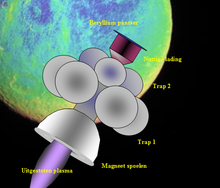Daedalus project
The Daedalus project was a study carried out by the British Interplanetary Society between 1973 and 1978 with the aim of creating a realistic design of an interstellar unmanned spacecraft . The requirement was that the spaceship had to be based on technology that was already available or that could be achieved in the near future and that it should achieve its goal within a person's lifetime (~ 50 years). The chosen target was Barnard's Arrow Star , which is 5.9 light years away from our solar system, with the unmanned spaceship also approaching several stars. Because of the expected enormous costs, the study was never seriously considered as a space project, let alone implemented.
The result of the study
The design envisaged a two-stage spacecraft propelled by inertial fusion . This unmanned spacecraft should be able to operate in an automated manner, because the distance to the earth means that there is too great a time delay in communication (years to decades). Since the spacecraft was not intended to be slowed down, it was supposed to transport several tons of scientific payload in order to be able to examine the interstellar space and the star systems more closely. The following is a list of the dimensions:
| Takeoff mass: | 54,000 t |
| Fuel mass: | 50,000 t |
| Structure mass: | 3,500 t |
| Payload mass: | 500 t |
Protective shield
Due to the high speed, the presence of micrometeorids and interstellar dust , the spaceship is equipped with a 50 t heavy and 7 mm thick beryllium plate. If the spaceship approaches a star system, a second type of protective shield should be established. 200 km in front of the spaceship, robots are supposed to generate a cloud of particles, which should prevent any "garbage" from colliding with the spaceship.
payload
In addition to the central computers, the spaceship will also contain maintenance robots that will check, maintain and repair the spaceship for leaks and prepare the space probes for exploring the star system. 18 space probes that are equipped with artificial intelligence are to be carried. Carried telescopes should examine a star system before reaching and flying past, u. a. also on possible planets in the system.
Drive system
In order to reach Barnard's star in the desired flight time, a non-chemical propulsion system is necessary that would achieve the necessary speed of 16% the speed of light . (Note: the maximum speed is higher than the average speed in order to compensate for the time lost during the long acceleration phase). This selected propulsion system was already considered in the Orion project : the nuclear pulse propulsion . In contrast to the Orion project, which is supposed to generate the thrust with small nuclear charges, the team from the Daedalus project relied on inertial fusion . Deuterium and helium-3 will serve as fuel for a deuterium-helium-3 fusion . This type of energy release can produce small detonations, in contrast to fission , which transmit an impulse to the spaceship and thereby accelerate it.
With the drive, small pellets (2-4 cm) with a superconducting coating are to be shot into the reaction chamber by means of an electromagnetic accelerator (a kind of rail gun ). Electron beams that run perpendicular to the direction of injection initiate the fusion ignition in the event of a collision. In order to generate the necessary thrust, 250 pellets per second are required. The end products ( plasma ) are guided out of the combustion chamber by means of a magnetic nozzle and generate the necessary thrust when they exit.
The mission sequence
The construction of the spaceship was planned in the orbit of Jupiter , as this should provide the necessary helium-3 fuel . In addition, ignition of the engines at the start of the mission in near-Earth space was viewed as critical (interaction of the released plasma with the earth's magnetic field).
The first stage should be ignited at the start of the mission. This should generate a thrust for about 2 years that would accelerate the spaceship to about 7% of the speed of light, using 46,000 tons of fuel. After the separation of the first stage, the second stage should ignite and consume 450 t of fuel in the following 1.8 years. Then the acceleration-free flight to the target star system should begin, during which the unmanned spaceship should investigate the interstellar space.
When half of the mission's duration has been reached, begin an initial observation of the star system with the telescopes carried. The second phase begins seven years before reaching the system with the start of the first, and two years beforehand with the second space probe. The third phase should include the approach and the flyby, during which the spaceship could take the sharpest pictures with the internal telescopes. The flyby should only take 70 hours.
literature
- Project Daedalus Study Group: A. Bond et al., Project Daedalus - The Final Report on the BIS Starship Study , JBIS Interstellar Studies, Supplement 1978
Web links
- Project Daedalus - Origins. Archived from the original on November 21, 2007 ; accessed on April 30, 2011 (English).
- Thorsten Dambeck: Project "Dädalus", star voyage with mini bombs , in Spiegel Online , date: November 29, 2005, accessed: March 3, 2012
- Remembering Project Daedalus centauri-dreams.org, accessed on November 10, 2012
Individual evidence
- ↑ a b c d e f Adrian Mann: Starship Daedalus. bisbis.com, accessed August 28, 2014 .
- ↑ a b c d e Project Daedalus. daviddarling.info, accessed April 30, 2011 .
- ↑ Colin Johnston: The stars our destination? (PDF; 528 kB) Astronotes, December 2007, accessed on April 30, 2011 (English).
- ^ KF Long et al .: PROJECT ICARUS: Son of Daedalus Flying Closer to Another Star . Ed .: Joint Tau Zero Foundation, British Interplanetary Society. May 24, 2010, arxiv : 1005.3833 (English).
